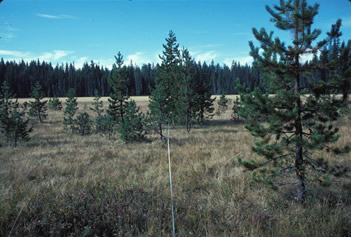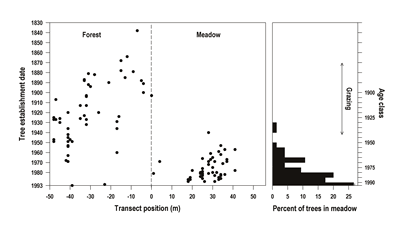|
Within the last century there has been widespread establishment of trees
in mountain meadows of the Pacific Northwest. We reconstructed patterns of tree invasion
at 17 meadow sites in the central Cascade Range of Oregon, U.S.A.— sites
representing diverse physical environments and vegetation types, and
experiencing different histories of recent anthropogenic disturbance
(sheep grazing). Spatial distributions
and age structures of tree populations were analyzed with respect to
climatic histories and grazing records.
Patterns of establishment varied considerably among meadows, reflecting
strong differences in site environment and grazing history.
In hydric montane meadows, tree establishment was spatially clumped
beneath large, old trees and on elevated microsites, however the timing
of invasion differed between sites with stable and fluctuating water
tables. In upland mesic/dry montane meadows, timing
of invasion correlated with cessation of sheep grazing (early 1940s)
and the onset of wetter summers (mid 1940s).
In the subalpine zone, climate and aspect interacted to produce
contrasting histories of invasion on north- and south-facing slopes. Establishment on N-facing slopes, concentrated
in heath-shrub communities, coincided with regional warming (ca. 1920-1945)
when snowpacks were lighter and melted earlier. Recruitment of trees onto S-facing slopes occurred
later, when climate was wetter (1945-1985).
In many environments, the spatial distribution of recruitment suggests
that once trees have established, autogenic factors become increasingly
important as individual trees or groups of trees alter the physical
or biotic conditions that once inhibited establishment. Knowledge of the factors that influence invasion,
and of their varying importance across gradients in environment and
vegetation, is critical to predicting future changes in these dynamic
systems.
|
|

Transect line spanning a forest - meadow ecotone where
lodgepole pine has invaded Deschampsia meadow.

Spatial
and temporal patterns of conifer establishment across a SW-facing
forest - meadow ecotone at 1500 m elevation. Points represent dates
of establishment vs. distance from forest edge (vertical dashed line).
Bars
represent
age structure of trees in the meadow. The period of sheep grazing
is defined by the two-ended arrow.
|

